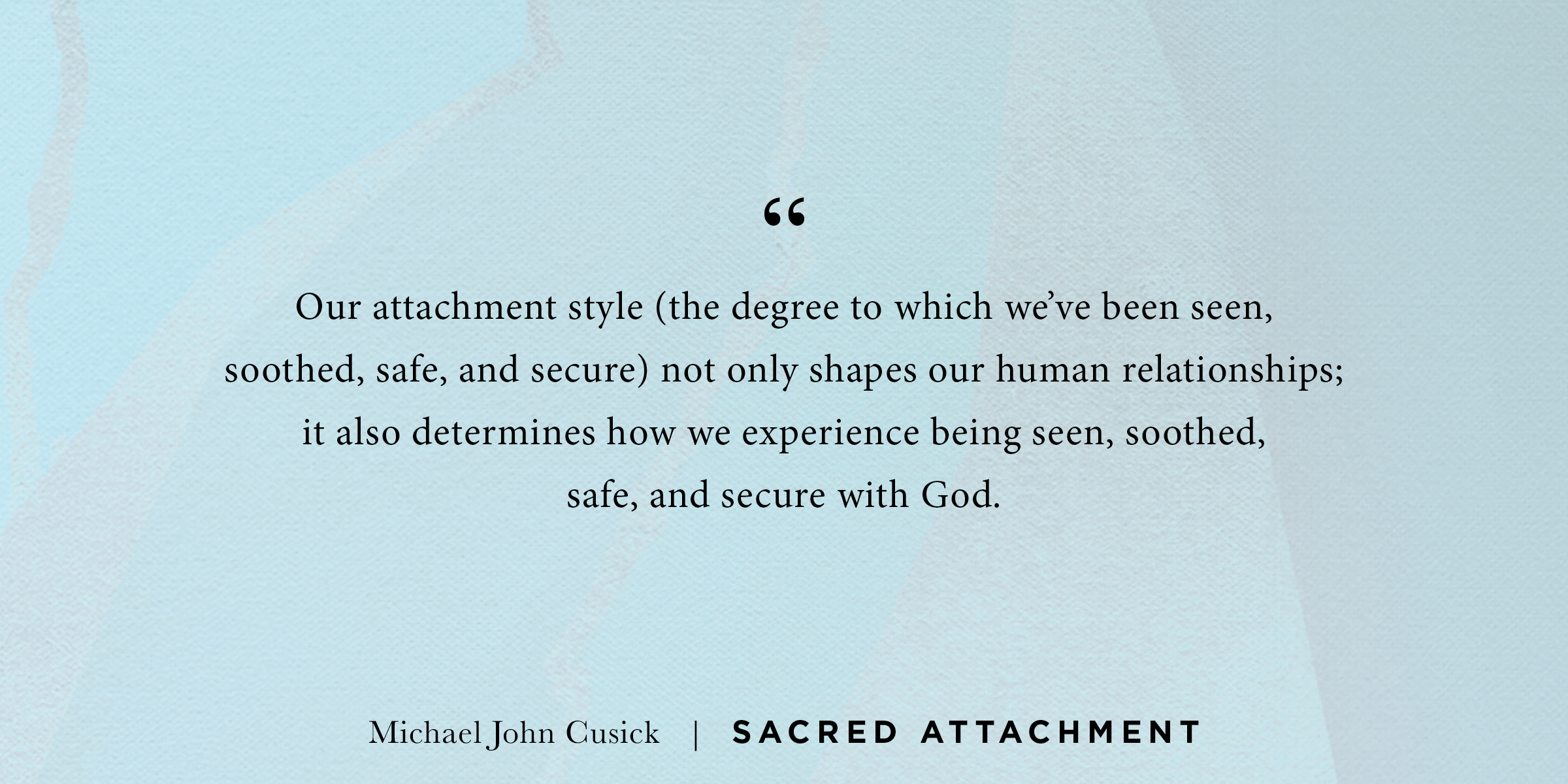What We Need for Secure Attachment
Michael Cusick, RTS’s co-founder and CEO, has written a new book titled Sacred Attachment — but what does attachment really mean? In this excerpt from the book, Michael explains the four needs that contribute to attachment: to be seen, soothed, safe, and secure.

I wanted to begin my role as a father to Lily with extra intentional care. To let go of all the challenges of the [adoption] process and to embrace my baby daughter.
She looked so innocent, so beautifully dependent on me and her new mom. Cradling her in my arms, gently swaying to rock her to sleep, I sensed a visceral power rising within me, a primal urge to protect her, nurture her, and defend her with my life if needed. Seeing how helpless she was, surely this was what any parent would feel.
Shortly after her arrival, however, I began to experience something completely unexpected at the opposite end of the emotional spectrum. Previously buried memories of my childhood sexual abuse surfaced and caused panic attacks as a result of post-traumatic stress disorder (PTSD). While I had already remembered more than enough of the unbearable incidents of abuse I suffered, these new memories felt exponentially worse. [...]
While the two concurrent emotional experiences — welcoming and holding our daughter as well as remembering and reacting to new horrific memories of my childhood — seemed coincidental, I eventually realized what they had in common. They both revolved around attachment. [...]
Understanding what contributes to secure attachment
And what I longed for and needed as I absorbed the impact of such horrendous memories were the same four things my new baby daughter needed — to be seen, soothed, safe, and secure. My understanding of these four basic human needs has been greatly impacted by the work of Dr. Curt Thompson, a psychiatrist and author who focuses on the intersection of Christian spirituality and interpersonal neurobiology (IPNF), who credits Dan Siegel, a child psychiatrist and professor of psychiatry at the UCLA School of Medicine.
My understanding of these four basic human needs has been greatly impacted by the work of Dr. Curt Thompson, a psychiatrist and author who focuses on the intersection of Christian spirituality and interpersonal neurobiology (IPNF), who credits Dan Siegel, a child psychiatrist and professor of psychiatry at the UCLA School of Medicine.
Based on their work over the past twenty-plus years, I’ve further developed the model of what I call the Four S’s (seen, soothed, safe, secure) as a way of understanding who we are and how we move through the world. I’ve found ways to describe the human needs we all experience — from cradle to grave.
I’m convinced most problems disrupting our lives and impeding healthy psychological function are the direct result of how we have been seen, soothed, safe and secure. Or, as is often the case, how those needs have gone unmet in our lives.
Why attachment matters
These four S-words summarize the fundamental human needs each of us experiences as newborns, as children, as adolescents, and as adults.
These needs are wired into our DNA to ensure our survival and ability to thrive in the world. We must rely on relationships with others around us in order for these needs to be met. The method and degree to which they were met when we were babies and children also determines how we learn to relate to the world around us. Or as we counselors like to say, these needs shape our ability to attach and form healthy, securely attached relationships—or not.
A secure attachment is the basis for being able to trust and to have a solid sense of self, being able to experience (through your five senses) healthy intimacy whether together or apart with others in relationship. Securely attached, you practice the ability to take care of yourself as well as ask for help as needed. Curt Thompson explains, “Security is about being able, in the face of feeling seen, soothed, and safe, to move away from our relational base and step out to take the risk of new adventure, whether it’s across the crib, across the room, or across the country.”
1. Seen
The first ingredient of this secure attachment is being seen.
In its primary form, being seen is the awareness a baby has that her mother knows she is there and understands what she needs. Developmentally, a baby’s eyes cannot discern depth and distance during their first few months. Initially, infants are drawn to bright colors and large shapes before recognizing the faces and expressions of the people around them. Long before babies can look into the eyes of their parent or caregiver, they know whether or not they are being seen.
2. Soothed
Caregivers who are engaged and attuned to newborns pay attention to these tiny, dependent creatures in their care. They use soft voices, make eye contact, sing lullabies, anticipate feeding times and diaper changes. And when the child is seen, it’s natural for the child to be soothed by those tending them. Soothing is about the need for comfort, for assurance, for presence, for a sense that their discomfort, pain, fear, or anxiety is recognized, acknowledged, and then remedied if possible.
So often as adults, we long to be soothed but never received healthy soothing or learned constructive ways to self-soothe as we matured. If our caregivers failed to soothe us adequately, consistently, lovingly, then by default we learned to soothe ourselves. We learned to live without soothing and to survive on our own. Our survival strategies compelled us to turn to habits, substances, and relationships to get substitutes or counterfeits for our comfort and soothing.
Touching and pleasuring our own bodies, sucking our thumb or fingers, rocking ourselves, and relying on objects such as blankets or stuffed animals are some of the ways we calm and comfort ourselves when others aren’t attending us, holding us, patting us, assuring us.
If we were not soothed, then our survival strategies continued through each stage of development, often predisposing us to addictions that provide quick hits of pleasure, escape from pain, and the release of endorphins and neurochemicals that calm and satiate us. Of course, there are healthy ways we can soothe ourselves — being attuned to what our body needs and providing it (nourishment? hydration? rest? exercise?), relaxing and spending time outdoors, finding physical activities we enjoy, cultivating hobbies and interests.
3. Safe
Whether as infants or adults, as we draw conclusions about our needs to be seen and soothed, we begin to see how they relate to our needs for safety and security. Babies absorb the emotions of their caregivers and develop an awareness of their surroundings and any imminent dangers.
Toddlers who hurt themselves because no one stopped them from touching the flame of a candle, sharp objects, or unfriendly pets form an awareness that their surroundings are harmful, painful, and dangerous. Once their autonomous nervous systems are conditioned to being tripped frequently, then their heightened nervous systems remain in fight or flight, on red alert, regardless of whether there are any actual threats.
4. Secure
If the need for safety goes unmet consistently, then it’s likely a secure attachment will not develop. An overall sense of security remains lacking as well. If your caregivers did not see you and attune to your needs, if they failed to comfort and soothe you consistently when you experienced pain of any kind, if they could not assure your safety—or worse, harmed you themselves, directly or indirectly—then a sense of security could never develop. Security requires loving presence that is consistent and predictable.
We expect the children in our lives to be needy and dependent. As they mature into adulthood, however, we expect them to grow, learn, and become independent. We hold these expectations for ourselves as well. Only here’s the problem: What if we have failed to grasp the extent of our secure attachment needs and the impact of how our needs were and were not met while growing up?
Please listen carefully. The way we relate to our environment, events, and other people often results more from our past conditioning than our present choosing. Our early development and family of origin profoundly affected our nervous system. Which determined whether or not we would have a secure attachment. And that wiring is the basis for trust, including trusting in divine love.

To learn more about how to heal and experience a more secure attachment to divine love, you can check out the first chapter of Sacred Attachment or pre-order your copy.
Taken from Sacred Attachment by Michael John Cusick. Copyright (c) 2025 by Michael John Cusick. Used by permission of InterVarsity Press. www.ivpress.com